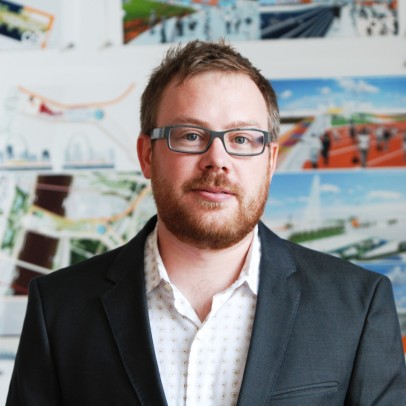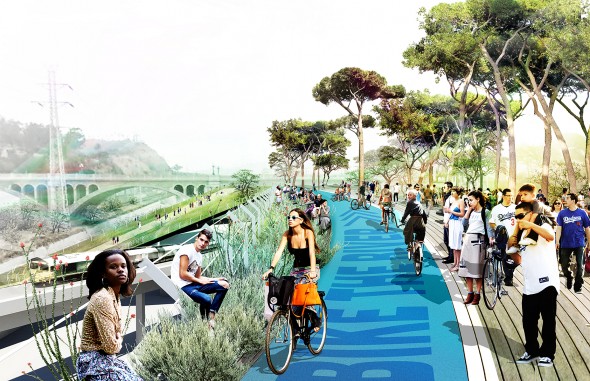Architect reimagines play in Denver, reinvents riverbed in L.A.

Andrew Moddrell is collaborating on the design of a Denver park and 51 miles of greenway along the Los Angeles River, now a concrete channel. “A lot of people in L.A. don’t know they have a river,” says Moddrell, assistant professor of architecture.
After more than a year’s work on a new $5 million design for Denver’s City Park, Andrew Moddrell is back to the drawing board.
Nine months in, the project ran into opposition from a neighborhood group of about 100 people.
“They don’t want their park to change,” said Moddrell, an assistant professor of architecture and partner in PORT Architecture and Urbanism.
PORT partnered on the project with Denver-based Indie Architecture, run by UIC School of Architecture faculty member Paul Andersen.
Moddrell compares the park, Denver’s largest, to Chicago’s Grant Park.
“There was the opportunity to essentially ‘Reimagine Play’ — the name of the competition — and create a multigenerational civic space that would allow people to engage in a healthy and active lifestyle,” Moddrell said. “You could play chess, run, see a movie in the park in addition to play for all ages.”
First order of business, he said, was “to replace a crumbling, inaccessible playground.”
Planning included engaging the community — 42,000 people live within walking distance of the park — in many focus groups.
The project was called City Loop — for a half-mile-long mobility loop surrounding an eight-acre central lawn — and the opponents put up a website called stopcityloop.org.
“They pushed out a lot of misinformation,” Moddrell said of the opposition.
“We backed up a little bit and engaged in meetings to tailor the project to better meet their needs,” he said. “It was unsuccessful. Beyond repairing or replacing the playground, they were not willing to work with us to change their experience of the park.”
So PORT’s client, Denver Parks and Recreation, canceled the project on that site. The agency chose a new location — Paco Sanchez Park — and Moddrell and his partners began focusing there Sept. 1.
“It may not end up looking anything like the previous design,” he said. “We’ll sit down with the community for about six months and then go into fundraising — we’ll have the same goals, a public space in the city to promote healthy lifestyles.”
The other big plan he’s working on will lead to a 51-mile greenway, including a bike path, along the Los Angeles River by 2020.
“A lot of people in L.A. don’t know they have a river,” the architect said.
Since 1960 the riverbed has been a broad concrete channel familiar to anyone who’s seen “Grease” and a number of other Hollywood movies. The channel is dry except when it rains, at which point “it’s a raging channel for 24 hours,” Moddrell said. Eventually the concrete will be removed and the river will flow again.
PORT’s employer on this project is the Los Angeles River Revitalization Corp.; the $100 million project is called Greenway 2020.
Its completion will provide what Moddrell calls “a non-automotive mobility spine” for Los Angeles and 12 other municipalities. Cyclists will take it to such destinations as Griffith Park, Dodgers Stadium, downtown and Long Beach Harbor, with riverfront parks, cafes and equipment rentals along the way. Some 28 of the 51 miles are connected so far. There are about 60 intersections, overpasses and train crossings to pass under, over or through.
Why is his firm named PORT?
“A port is a place of exchanges and collaboration,” the architect said. Also, when he and his partner in the firm, Christopher Marcinkoski, co-authored their master’s degree thesis at Yale University, “a lot of our research was on port terminals.”
Moddrell was awarded the H.I. Feldman Prize for Design Excellence at Yale. At the University of Kansas, where he earned a bachelor’s degree with distinction, he won the Thayer Medal for Architectural Design.
Growing up in Lawrence, Kansas, he started going to University of Kansas Jayhawks basketball games at age 4 or 5. Next to architecture, he said he spends the most time being a college basketball fan. And like many other Lawrence natives, “I’m completely irrational about it,” he said.
Moddrell spent four years with the firm headed by the late Doug Garofolo, a UIC professor, and two-and-a-half years with UrbanLab, where associate professor Sarah Dunn is a partner. He taught at the Illinois Institute of Technology for three years before joining UIC in 2008.
Moddrell recently moved to Lincoln Park after living in Marina City for seven years. His wife, Melissa, is a physician’s assistant in cardiac surgery at Northwestern Memorial Hospital. Their son, Max, was born April 27.
Another big change in April: his firm moved into the historic Monadnock Building, the brown brick structure at 53 W. Jackson Blvd. designed by Daniel Burnham in 1893. “As an architect, it’s especially nice to go to work every day in a beautiful and iconic building,” Moddrell said.

